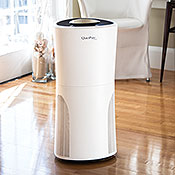This is a sponsored post.
For people with allergies and asthma, getting rid of allergy triggers is often a high priority and for most, one of the main triggers can be odor.
What are some of the biggest odor allergy triggers?
- flowers
- candles
- perfumes
- burned food
- pets
- aerosol air fresheners
- ozone
Some of these odors can be classified as a volatile organic compound (VOC), which are potentially hazardous chemicals that become vapor in the air at ordinary room temperature. To combat odor allergy triggers and VOCs takeover of an indoor space, many air purifiers began placing technology in their units that emitted ozone (a molecule made from three oxygen atoms). Ozone can help destroy some sources that cause odor by oxidizing them.
If ozone is so good, why not use ozone even more?
Breathing ozone can be more harmful than just as an allergy trigger, it can be very bad for your lungs and is not ideal, especially for people who have respiratory challenges like asthma. It can badly affect not just people within a home, but pets too. It’s an effective way of removing odor but for health it’s best to avoid ozone.
What are some other non-ozone producing air purifiers?
Advancements in air purification have made it possible to rid your indoor space of VOCs and odor allergy triggers without harmful methods. The best combination to look for is an air purifier is a HEPA (High Efficiency Particulate Air) filter and a carbon filter. The HEPA filter will help remove tiny particulate from your air supply, while the carbon will help neutralize odors.

Is it better to have a carbon filter with a HEPA filter?
HEPA and carbon filters have been extensively tested and totally safe for use in homes that have children, pets, allergy and asthma suffers, and anyone with compromised immunity issues.
HEPA filters have long been known as the gold standard of filters. They remove most of the airborne particles in your home that can trigger allergies and asthma. Think about spring and fall allergy seasons: pollen, regardless of how diligent you are, can find its way into your home and wreak havoc on anyone who’s sensitive to it. HEPA filters can capture that teeny-tiny particulate and remove it from the air.
Beware non-HEPA air filters
Be sure when you’re looking for an air purifier that you find one offering True HEPA, which is defined as being able to trap 99.97% of dust and allergy particles down to 0.3 microns in diameter (a micron is one millionth of a meter). A True HEPA filter will always display the percentage and/or micron level; products featuring “HEPA-like” or “HEPA-type” filters will not. There’s a tougher standard than HEPA called ULPA (Ultra-low Penetration Air) that can get 99.99% of particles 0.12 microns and above, but that doesn’t exactly translate into being a better fit for air purifiers and vacuums. Air purifiers using ULPA filters will actually be less effective when it comes to reducing particulate than an air purifier with a HEPA filter due to the slower airflow through the denser ULPA filter.
HEPA air filters are more than Air Purifiers
Air purifiers aren’t the only healthy home tools that feature HEPA. Increasingly, vacuums are equipped with sealed HEPA filters that are designed to effectively trap the dust and particulate that you’ve just sucked up out of the carpet, preventing it from escaping the vacuum and reentering your air supply.
For households with people who have severe asthma and allergies, it may be necessary to have more than one HEPA air purifier in your home; most residential air purifiers can’t effectively cover an entire home, especially if certain rooms have closed doors where air can’t freely circulate. Placing a unit in each of the main living areas (den, kitchen, bedrooms) can be more of a monetary investment, but can actually go much further in reducing the likelihood of experiencing asthma and allergy symptoms.



